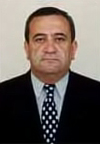Politics in Estonia takes place in a framework of a parliamentary representative democratic republic, whereby the Prime Minister of Estonia is the head of government, and of a multi-party system. Legislative power is vested in the Estonian parliament. Executive power is exercised by the government, which is led by the prime minister. The judiciary is independent of the executive and the legislature. Estonia is a member of the United Nations, the European Union, and NATO.

The Government of the Republic of Armenia or the executive branch of the Armenian government is an executive council of government ministers in Armenia. It is one of the three main governmental branches of Armenia and is headed by the Prime Minister of Armenia.

The Control Yuan is the supervisory and auditory branch of the government of the Republic of China, both during its time in mainland China and Taiwan.

The prime minister of the Lao People's Democratic Republic, formerly the chairman of the Council of Government of the Lao People's Democratic Republic, is the head of government of Laos. The prime minister is accountable to the president, the National Assembly and the country's only legal party: the Lao People's Revolutionary Party (LPRP). The current prime minister is Sonexay Siphandone, who was elected in 2022.

The National Assembly of the Socialist Republic of Vietnam is the unicameral parliament and the highest body of state power of Vietnam. The National Assembly is the only branch of government in Vietnam and, in accordance with the principle of unified power, all state organs are subservient to it.

The National Assembly Standing Committee, formerly organized as the Council of State, is the highest standing body of the National Assembly of Vietnam. Its members are elected from among National Assembly deputies, including the Chairman/Chairwoman, Deputy Chairmen/Chairwomen, and other standing members. The number of the Standing Committee's members is decided by the National Assembly, these members must not concurrently hold a position in the cabinet. The Standing Committee of previous term shall continue their duties until the newly elected National Assembly establishes its new Standing Committee.

The Senate of Kazakhstan is the upper house of two chambers in Kazakhstan's legislature, known as the Parliament (Parlamenti). The Senate is composed of elected members: two from each region and two from three municipalities which are Almaty, Astana, and Shymkent.

The Central Bank of Armenia is the central bank of Armenia with its headquarters in Yerevan. The CBA is an independent institution responsible for issuing all banknotes and coins in the country, overseeing and regulating the banking sector and keeping the government's currency reserves. The CBA is also the sole owner of the Armenian Mint.

The Government of Romania forms one half of the executive branch of the government of Romania. It is headed by the Prime Minister of Romania, and consists of the ministries, various subordinate institutions and agencies, and the 42 prefectures. The seat of the Romanian Government is at Victoria Palace in Bucharest.

The Court of Audit of the Republic of Slovenia is the highest body for supervising state accounts, the state budget and all public spending in Slovenia. The Constitution of Slovenia further provides that the Court of Audit is independent in the performance of its duties and bound by the Constitution and law. The Court of Audit Act also defines that the acts with which Court of Audit exercises its powers of audit cannot be challenged before the courts or other state bodies.
The Ministry of Finance of Ukraine is the ministry of the Ukrainian government charged with developing and implementing national financial and budget policies, and with defining national policies in customs and taxation. The ministry is responsible for ensuring that the state has enough resources to perform its functions and that financial policies promote economic growth.

The Ministry of Hotels and Tourism is a ministry in the Burmese government responsible for the country's tourism sector.

Accounts Chamber of the Russian Federation is the parliamentary body of financial control in the Russian Federation.

The Constitutional Court of Armenia is the highest legal body for constitutional review in Armenia. It is responsible for supervising the constitutionality of laws and other legislative instruments. The law of the constitutional court is defined in the Armenian constitution and by statute. The court, established in 1995, is located in Yerevan.

The president of Armenia is the head of state and the guarantor of independence and territorial integrity of Armenia elected to a single seven-year term by the National Assembly of Armenia. Under Armenia's parliamentary system, the president is simply a figurehead and holds ceremonial duties, with most of the political power vested in the parliament and prime minister.

The Central Electoral Commission of Armenia (CEC) organizes elections and referendums in Armenia. The Commission oversees and regulates the electoral process, counts and publicizes results, among other duties. Before the formation of the Republic of Armenia in 1991, the Central Electoral Committee activities were carried out in accordance with Soviet Armenian laws set by the Election of People's Deputies. Electoral reforms were adopted in August 2011 concerning the organizing and conducting of presidential and regional elections in Armenia, three levels of electoral committees were established.

Ashot Kolya Yesayan is an Armenian politician.

Arpine Hovhannisyan is an Armenian politician, lawyer, former Minister of Justice of Armenia, and former vice president of the National Assembly of Armenia. Hovhannisyan is also the first female to ever hold the position of Justice Minister in Armenia. Currently a member of the Chamber of Advocates, she is fully engaged in a professional activity. During her political career, Hovhannisyan was member of the ruling Republican Party of Armenia (HHK), formerly a governing political force. She is not affiliated with any political party at present.

Nina Petrivna Yuzhanina – a Ukrainian economist and politician.People's Deputy of Ukraine since the 2014 Ukrainian parliamentary election.
The Chamber of Accounts of the Republic of Azerbaijan is a supreme audit institution, the highest financial control authority of the Republic of Azerbaijan.





















